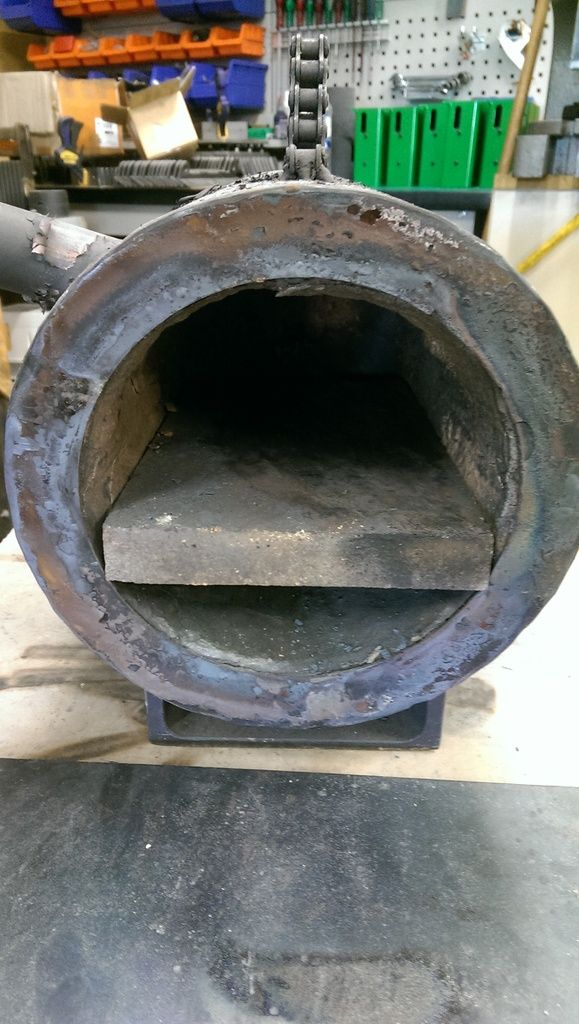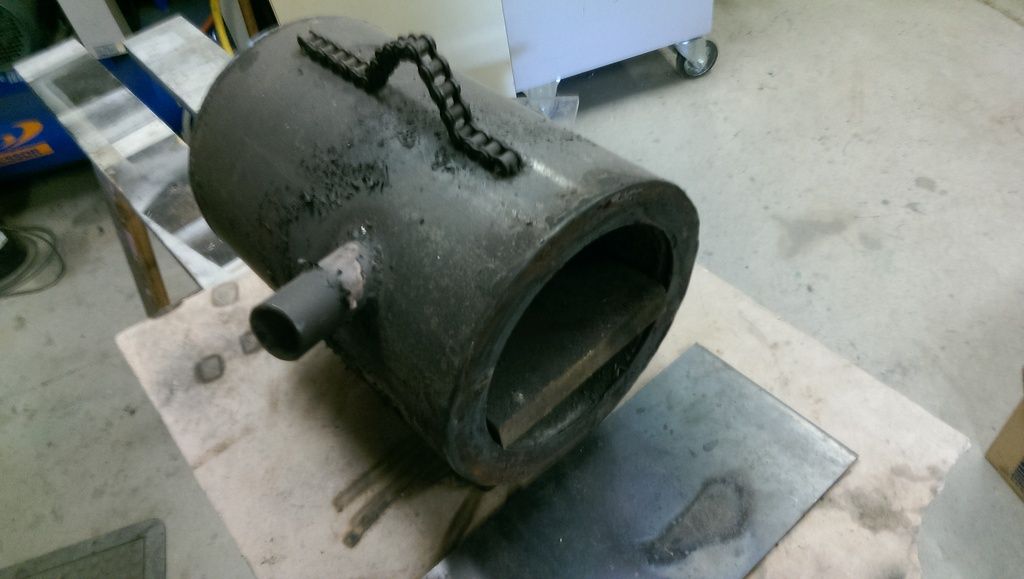 Needs Pictures: 0
Needs Pictures: 0
 Picture(s) thanks: 0
Picture(s) thanks: 0
Results 1 to 14 of 14
Thread: Etchant Tank.
-
3rd Dec 2015, 09:37 AM #1
 Etchant Tank.
Etchant Tank.
I am wanting to get some feed back on the suitability of using PVC storm water pipe and the screw on end caps as an etchant tank to hold acid.
One of these or a mix:
Hydrochloric, sulphuric, white vinegar, ferric, muratic.
So not sure what I will use yet or ratio.
How well will the PVC hold up and what about the rubber O-ring?
The purpose will be for etching patter welded material see post here: //metalworkforums.com/f266/t198502-cable-damascus…..Live a Quiet Life & Work with your Hands
-
3rd Dec 2015, 09:46 AM #2

Hi Dale,
PVC is ok for any of those acids. Viton O-rings are ok.
Ray
-
3rd Dec 2015, 11:24 AM #3
 Member: Blue and white apron brigade
Member: Blue and white apron brigade











- Join Date
- Feb 2006
- Location
- Perth
- Posts
- 7,189

It depends what sort of stormwater pipe you are referring to.
If it is that flimsy 90 mm diameter pinkish coloured stuff I wouldn't do it.
Not because of chemical resistance but because it's physically too fragile.
If you are talking about the thick walled white stuff then that is better.
-
3rd Dec 2015, 11:32 AM #4

Was thinking 100mm white or grey stuff
…..Live a Quiet Life & Work with your Hands
-
3rd Dec 2015, 11:51 AM #5

Ferric chloride is by far the best etchant to use for damascus Dale. I use a 400mm length of 100mm sewer pipe with a glued on bottom and a screw cap on top.
1915 17"x50" LeBlond heavy duty Lathe, 24" Queen city shaper, 1970's G Vernier FV.3.TO Universal Mill, 1958 Blohm HFS 6 surface grinder, 1942 Rivett 715 Lathe, 14"x40" Antrac Lathe, Startrite H225 Bandsaw, 1949 Hercus Camelback Drill press, 1947 Holbrook C10 Lathe.
-
3rd Dec 2015, 11:58 AM #6

What dilution ratio
…..Live a Quiet Life & Work with your Hands
-
3rd Dec 2015, 08:56 PM #7

Straight Dale, i think if it's powder you mix it 40% powder 60% water by weight.
Clean your blade with metho or acetone, dunk for 30 sec, rinse, rub with steel wool, dunk, repeat 4 or 5 times. If you just leave it in an oxide layer forms and slows the reaction right down.
Finish by sanding very lightly with 1200g or higher (2000 is good) paper on a hard block, just to polish the raised layers. Some say you need to neutralize the acid with bi-carb or similar, i just flood the blade with WD-40 and it seems to work fine.
The contrast of the etch will depend on the steels used, 10XX series and 15N20 give a great contrast. Try to avoid steels with chrome as it makes welding very hard.
Lastly, whilst i prefer the coke forge for a lot of work damascus is one thing where the cleanliness of a reducing atmosphere gas forge is preferred, you can weld at lower temps and control the temp so well.1915 17"x50" LeBlond heavy duty Lathe, 24" Queen city shaper, 1970's G Vernier FV.3.TO Universal Mill, 1958 Blohm HFS 6 surface grinder, 1942 Rivett 715 Lathe, 14"x40" Antrac Lathe, Startrite H225 Bandsaw, 1949 Hercus Camelback Drill press, 1947 Holbrook C10 Lathe.
-
3rd Dec 2015, 09:00 PM #8

Thanks Ewan.
The gas forge is on the to do list. I actually went and tried to buy some koawool blanket, and fire brick today, unsuccessfully.
Cable is probably better done in the coke forge simply due to the large amounts of Borax required. It would eat through the gas forge.…..Live a Quiet Life & Work with your Hands
-
3rd Dec 2015, 09:17 PM #9

You just need to use a shelf to protect your lining.
Look at TVF's website, i have both a "little pig" from Karim and a bigger 9kg from BSG. The 9kg has a cast floor and takes ages to heat up but is very stable due to the thermal mass. However the chamber is too big for damascus and even with a big burner my reg freezes up after about 30min of use.
On the borax though.....you don't really need it. Soak the cable (or your billet) in kero first and then put it in the hot forge. The kero burns and leaves a nice thick carbon layer that protects the steel. With the gas forge you can run it rich and bareback weld damascus, no need for flux at all.
Building a gas forge
This is not a Pig, the pigs have no door and you just block one side in. I'll take a photo or 2 when i get the time.1915 17"x50" LeBlond heavy duty Lathe, 24" Queen city shaper, 1970's G Vernier FV.3.TO Universal Mill, 1958 Blohm HFS 6 surface grinder, 1942 Rivett 715 Lathe, 14"x40" Antrac Lathe, Startrite H225 Bandsaw, 1949 Hercus Camelback Drill press, 1947 Holbrook C10 Lathe.
-
5th Dec 2015, 09:58 AM #10
 Member: Blue and white apron brigade
Member: Blue and white apron brigade











- Join Date
- Feb 2006
- Location
- Perth
- Posts
- 7,189

Does the Kero method work for any steel and does it work if the steel is directly under the flame?
My problem has been scale - running the flame rich reduces this problem significantly but any steel in direct contact with the flame still seems to suffer.
I've been using a n internal chamber made from piece of SHS to prevent flame contact on the material and it seems to work.
-
5th Dec 2015, 09:15 PM #11

I have not tried it for HT Bob, only for damascus. I do not have any problem with scale in my forges unless i am using a steel that needs a long soak time like 52100 or O-1. Even then it is minimal if the forge is tuned properly. The RHS is a good solution though, not only does it protect the steel it evens out the heat too.
Are you using a pyrometer or thermocouple for monitoring your temp? I am wondering if you are running your forge too hot and pulling the blades out at the right moment rather than running on temp?1915 17"x50" LeBlond heavy duty Lathe, 24" Queen city shaper, 1970's G Vernier FV.3.TO Universal Mill, 1958 Blohm HFS 6 surface grinder, 1942 Rivett 715 Lathe, 14"x40" Antrac Lathe, Startrite H225 Bandsaw, 1949 Hercus Camelback Drill press, 1947 Holbrook C10 Lathe.
-
5th Dec 2015, 09:23 PM #12
 1915 17"x50" LeBlond heavy duty Lathe, 24" Queen city shaper, 1970's G Vernier FV.3.TO Universal Mill, 1958 Blohm HFS 6 surface grinder, 1942 Rivett 715 Lathe, 14"x40" Antrac Lathe, Startrite H225 Bandsaw, 1949 Hercus Camelback Drill press, 1947 Holbrook C10 Lathe.
1915 17"x50" LeBlond heavy duty Lathe, 24" Queen city shaper, 1970's G Vernier FV.3.TO Universal Mill, 1958 Blohm HFS 6 surface grinder, 1942 Rivett 715 Lathe, 14"x40" Antrac Lathe, Startrite H225 Bandsaw, 1949 Hercus Camelback Drill press, 1947 Holbrook C10 Lathe.
-
5th Dec 2015, 10:58 PM #13
 Member: Blue and white apron brigade
Member: Blue and white apron brigade











- Join Date
- Feb 2006
- Location
- Perth
- Posts
- 7,189

Because I don't use it all that often I'm still getting the hang of using this forge.
I just used to run the thing flat out but I can now set a sort of a temp after some too-ing and fro-ing with the gas/air controls.
Except for where the flame impacts directly onto metal I have definitely decreased the amount of scale by regulating the gas/air ratio.
Using the SHS "oven" reduces the impact of the flame problem so I am happy enough with things at the moment - I just wanted to know if the kero would make an even greater difference
I use both a TC and a pyrometer.
The TC is placed under the workpiece but there's no doubt that thin workpiece edges get hotter.
The TC gives me a sort of average forge temp but the the pyro easily enables me to measure the temp variation across a piece like how hot the edges are. Even using the SHS "oven" there is a 10-30º difference.
-
5th Dec 2015, 11:09 PM #14

Bob for HT i put the blade under the burner entry so there is no direct flame from the burner. Once the forge is hot you can't see a flame anyway, the whole interior of the forge is "on fire". My TC is under the burner as well. I find it best to get the forge to the right temp first (it can be hard to get it low enough) with plenty of "dragons breath" coming out the door. If you turn the air down to a point were it just stops roaring loudly you know you have a rich mix. I think i run about 3-4 psi to get 800c or there abouts.
1915 17"x50" LeBlond heavy duty Lathe, 24" Queen city shaper, 1970's G Vernier FV.3.TO Universal Mill, 1958 Blohm HFS 6 surface grinder, 1942 Rivett 715 Lathe, 14"x40" Antrac Lathe, Startrite H225 Bandsaw, 1949 Hercus Camelback Drill press, 1947 Holbrook C10 Lathe.
Similar Threads
-
New project - Diesel tank
By jex in forum WELDINGReplies: 20Last Post: 3rd Jun 2015, 04:13 PM -
Petrol tank
By gooddroprob in forum METALWORK GENERALReplies: 19Last Post: 3rd Oct 2014, 09:23 AM -
smithy leg vice 'n' tank
By AndrewOC in forum THE SMITHYReplies: 5Last Post: 14th Nov 2012, 10:14 PM -
Coollant Tank
By BobL in forum METALWORK GENERALReplies: 22Last Post: 26th Mar 2012, 04:04 PM -
adding a coolant tank
By Dusty Wheels in forum METALWORK GENERALReplies: 21Last Post: 24th Jun 2007, 01:24 PM



 Thanks:
Thanks:  Likes:
Likes: 
 Reply With Quote
Reply With Quote


